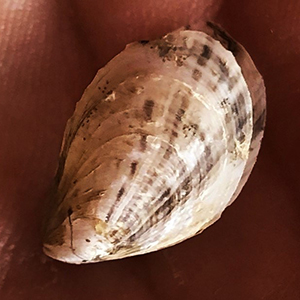Environmental DNA survey indicates arrival of quagga mussel in Ticino River basin

Submitted: 21 November 2022
Accepted: 17 March 2023
Published: 5 April 2023
Accepted: 17 March 2023
Abstract Views: 1919
PDF: 396
Supplementary: 64
HTML: 20
Supplementary: 64
HTML: 20
Publisher's note
All claims expressed in this article are solely those of the authors and do not necessarily represent those of their affiliated organizations, or those of the publisher, the editors and the reviewers. Any product that may be evaluated in this article or claim that may be made by its manufacturer is not guaranteed or endorsed by the publisher.
All claims expressed in this article are solely those of the authors and do not necessarily represent those of their affiliated organizations, or those of the publisher, the editors and the reviewers. Any product that may be evaluated in this article or claim that may be made by its manufacturer is not guaranteed or endorsed by the publisher.
Similar Articles
- La-orsri Sanoamuang, Santi Watiroyram, Allodiaptomus nongensis, a new diaptomid copepod (Copepoda: Calanoida) from a tributary of the Mekong River, with notes on its consumption by local people in Central Laos , Journal of Limnology: Vol. 78 No. 2 (2019)
- Federico Marrone, Valentina Pieri, Souâd Turki, Giampaolo Rossetti, The Recent non-marine ostracods of Tunisia: an updated checklist with remarks on their regional distribution patterns and ecological preferences , Journal of Limnology: Vol. 79 No. 3 (2020)
- Broughton A. Caldwell, Richard E. Jacobsen, A new species of Heterotrissocladius Spärck, 1923 (Diptera: Chironomidae: Orthocladiinae) from Georgia, USA , Journal of Limnology: Vol. 77 No. s1 (2018): Recent advances in the study of Chironomidae: An overview
- Kay Van Damme, Supiyanit Maiphae, Salinalona gen. nov., an euryhaline chydorid lineage (Crustacea: Branchiopoda: Cladocera: Anomopoda) from the Oriental region , Journal of Limnology: Vol. 72 No. s2 (2013): Freshwater Invertebrates of Southeast Asia
- Luc De Meester, Jelena Pantel, Eco-evolutionary dynamics in freshwater systems , Journal of Limnology: Vol. 73 No. s1 (2014): Limnology in the 21st Century: celebrating 75 years of ecological research in Pallanza
- Ranielle Daiana dos Santos Silva, Juliana Santos Severiano, Dayany Aguiar de Oliveira, Camila Ferreira Mendes, Vanessa Virgínia Barbosa, Mathias Ahii Chia, José Etham de Lucena Barbosa, Spatio-temporal variation of cyanobacteria and cyanotoxins in public supply reservoirs of the semi-arid region of Brazil , Journal of Limnology: Vol. 79 No. 1 (2020)
- Danyang Danyang, Chenhao Li, Lijie Pu, Hugejiletu Hugejiletu, Xiaojing Suo, Ming Zhu, Yalu Zhang, Xiaoqing Wang, Gaili He, Dejing Chen, Changes in and driving factors of the lake area of Huri Chagannao’er Lake in Inner Mongolia , Journal of Limnology: Vol. 81 (2022)
- Petra HÁJKOVÁ, Jindřiška BOJKOVÁ, Markéta FRÁNKOVÁ, Věra OPRAVILOVÁ, Michal HÁJEK, Kateřina KINTROVÁ, Michal HORSÁK, Disentangling the effects of water chemistry and substratum structure on moss-dwelling unicellular and multicellular micro-organisms in spring-fens , Journal of Limnology: Vol. 70 No. s1 (2011): Springs: neglected key habitats for biodiversity conservation
- Kenneth H. NICHOLLS, Claudiu TUDORANCEA, Species-level and community-level data analyses reveal spatial differences and temporal change in the crustacean zooplankton of a large Canadian lake (Lake Simcoe, Ontario) , Journal of Limnology: Vol. 60 No. 2 (2001)
- Dorota Górniak, Renata Tandyrak, Katarzyna Parszuto, Joanna Misiun, Relationships between physico-chemical and microbiological parameters in the monimolimnion of a forest meromictic lake , Journal of Limnology: Vol. 73 No. 3 (2014)
<< < 57 58 59 60 61 62 63 64 65 66 > >>
You may also start an advanced similarity search for this article.

 https://doi.org/10.4081/jlimnol.2023.2105
https://doi.org/10.4081/jlimnol.2023.2105





